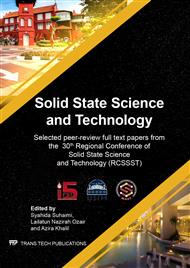p.84
p.93
p.98
p.104
p.113
p.119
p.125
p.131
p.136
Effect on Electrochemical Performance of Cr and Ni Substitution in LiCoO2 Cathode Materials
Abstract:
The effect of Cr and Ni substitution on electrochemical performance of layered LiCo0.9M0.1O2 (M=Cr and Ni) has been investigated. Partial substituted of LiCo0.9Cr0.1O2 and LiCo0.9Ni0.1O2 has been synthesized using a self-propagating combustion (SPC) method with annealing temperature of 700 ̊ C for 24 h. The starting materials used were metal nitrates and citric acid act as a combustion agent. The phase and crystalinity of the materials were characterized using X-Ray Diffraction (XRD) and results showed that the single phase and pure materials were obtained with no impurity peaks were detected. The morphology and particle sizes of samples also analyzed using Field Emission Scanning Electron Microcopy (FESEM). The electrochemical performances of the materials were measured by its charge-discharge cycling which carried out in the voltage range of 2.5 V to 4.5 V. The results from charge-discharge studies found that LiCo0.9Ni0.1O2 has better specific discharge capacity compared with LiCo0.9Cr0.1O2.
Info:
Periodical:
Pages:
113-118
Citation:
Online since:
July 2020
Price:
Сopyright:
© 2020 Trans Tech Publications Ltd. All Rights Reserved
Share:
Citation:


